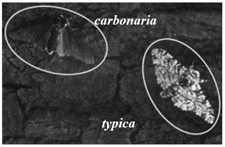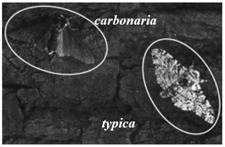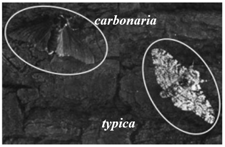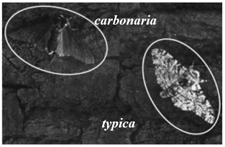Organic Evolution
Organic Evolution: Overview
This topic covers concepts, such as, Organic Evolution,Mechanism of Evolution,Darwin's Theory of Natural Selection etc.
Important Questions on Organic Evolution
"The ‘fitness’ of a population helps in evolution." The statement was given by:
All genetic changes occurring naturally are:
In the early part of the 19th century the common form of Biston betularia, called typica, had a peppered appearance. Its wings were flecked with black and white, and it was well camouflaged in its favourite resting place , the pale and lichen covered barks of trees in rural England. A dark or melanistic form of the moth, called, carbonaria, was first recorded in about 1848, and presumably had existed in very small numbers before them, but by the middle of 20th century, the melanistic form of the moth had come to represent over 95% of the Biston betularia population, especially in such industrial centres as Manchester and Liverpool. This is among the most rapid of all recorded evolutionary changes. Why was there such a dramatic change in fortune of the peppered typica and the melanistic carbonaria? With rapid industrialisation, soot came to cover the barks of trees, making them black instead of pale, and also killed the lichens. Now the melanistic form was better camouflaged on the darkened bark, while the peppered form became increasingly less camouflaged and hence more easily detected and eaten by birds. The birds, which had kept the melanistic form at a very low frequency before industrialisation, now concentrated their attention on the peppered-form. Natural selection, in the form of bird predation, favoured the peppered form earlier and the melanistic form later.
- Excert from survival strategies by Raghavendra gadagkar.
Select the option that correctly summarises the given observation in the passage.
In the early part of the 19th century the common form of Biston betularia, called typica, had a peppered appearance. Its wings were flecked with black and white, and it was well camouflaged in its favourite resting place , the pale and lichen covered barks of trees in rural England. A dark or melanistic form of the moth, called, carbonaria, was first recorded in about 1848, and presumably had existed in very small numbers before them, but by the middle of 20th century, the melanistic form of the moth had come to represent over 95% of the Biston betularia population, especially in such industrial centres as Manchester and Liverpool. This is among the most rapid of all recorded evolutionary changes. Why was there such a dramatic change in fortune of the peppered typica and the melanistic carbonaria? With rapid industrialisation, soot came to cover the barks of trees, making them black instead of pale, and also killed the lichens. Now the melanistic form was better camouflaged on the darkened bark, while the peppered form became increasingly less camouflaged and hence more easily detected and eaten by birds. The birds, which had kept the melanistic form at a very low frequency before industrialisation, now concentrated their attention on the peppered-form. Natural selection, in the form of bird predation, favoured the peppered form earlier and the melanistic form later.
- Excert from survival strategies by Raghavendra gadagkar.

In 1956, strict anti-pollution laws were enacted in England, which led to the countryside becoming creatively less polluted and free of smoke. One of the following was observed in 20 years from this event and is believed to be linked to this event. Which one could it be?
In the early part of the 19th century the common form of Biston betularia, called typica, had a peppered appearance. Its wings were flecked with black and white, and it was well camouflaged in its favourite resting place , the pale and lichen covered barks of trees in rural England. A dark or melanistic form of the moth, called, carbonaria, was first recorded in about 1848, and presumably had existed in very small numbers before them, but by the middle of 20th century, the melanistic form of the moth had come to represent over 95% of the Biston betularia population, especially in such industrial centres as Manchester and Liverpool. This is among the most rapid of all recorded evolutionary changes. Why was there such a dramatic change in fortune of the peppered typica and the melanistic carbonaria? With rapid industrialisation, soot came to cover the barks of trees, making them black instead of pale, and also killed the lichens. Now the melanistic form was better camouflaged on the darkened bark, while the peppered form became increasingly less camouflaged and hence more easily detected and eaten by birds. The birds, which had kept the melanistic form at a very low frequency before industrialisation, now concentrated their attention on the peppered-form. Natural selection, in the form of bird predation, favoured the peppered form earlier and the melanistic form later.
- Excert from survival strategies by Raghavendra gadagkar.
Which of the following correctly describes what is most likely to be passed on from a moth to its offspring?
In the early part of the 19th century the common form of Biston betularia, called typica, had a peppered appearance. Its wings were flecked with black and white, and it was well camouflaged in its favourite resting place , the pale and lichen covered barks of trees in rural England. A dark or melanistic form of the moth, called, carbonaria, was first recorded in about 1848, and presumably had existed in very small numbers before them, but by the middle of 20th century, the melanistic form of the moth had come to represent over 95% of the Biston betularia population, especially in such industrial centres as Manchester and Liverpool. This is among the most rapid of all recorded evolutionary changes. Why was there such a dramatic change in fortune of the peppered typica and the melanistic carbonaria? With rapid industrialisation, soot came to cover the barks of trees, making them black instead of pale, and also killed the lichens. Now the melanistic form was better camouflaged on the darkened bark, while the peppered form became increasingly less camouflaged and hence more easily detected and eaten by birds. The birds, which had kept the melanistic form at a very low frequency before industrialisation, now concentrated their attention on the peppered-form. Natural selection, in the form of bird predation, favoured the peppered form earlier and the melanistic form later.
- Excert from survival strategies by Raghavendra gadagkar.
Where did the variations seen in the appearance of the moth most likely come from?
Reproductive barriers are mechanisms which help maintain species over time. Three examples of reproductive barriers in certain species are given below:
A. Two species of garter snakes occur in the same area but one lives in water while the other is terrestrial.
B. Some salamander sub-species of genus Ensatina live in the same region and occasionally hybridise resulting in frail individuals in the next generation.
C. Blue-footed boobies (a type of bird) mate only after a courtship display wherein the male draws the female's attention to its bright blue feet.
Indicate whether these are examples of pre-zygotic or post-zygotic or post-zygotic reproductive barriers.
The most important theory of evolution was proposed by
The main point of Darwin's theory is
The concepts of natural selection in evolution were proposed by
For natural selection the important factor is
Hugo de Vries gave his mutation theory on organic evolution while working on
The material in which Hugo de Vries experimented to explain the mechanism of evolution thus pioneering the theory of mutations was
Which of the following is not under Darwin's theory of natural selection?
If the gene frequency occurs by chance it is termed as:
What is gene flow in humans?
Give some examples of natural selection.
What are the reasons for speciation according to Hugo De Vries?



